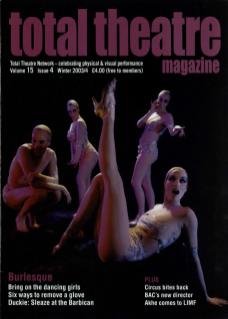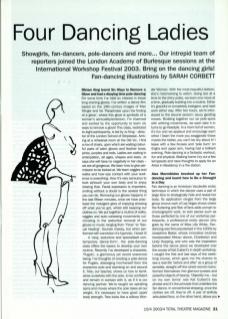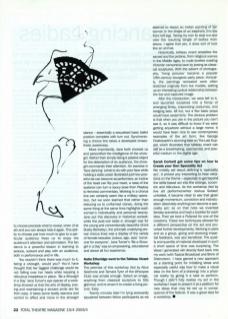Miriam King learnt Six Ways to Remove a Glove and had a dizzying time pole-dancing
For some time I've held an interest in those long evening gloves. I've written a dance film based on the 19th Century images of Max Klinger and his 'Paraphrase upon the finding of a glove', where this glove is symbolic of a woman's sensuality/eroticism. I'm charmed and excited by the opportunity to learn six ways to remove a glove! This class, restricted to eight participants, is led by Jo King – director of the London School of Striptease. Arriving at a rehearsal room at the Old Vic, I find a row of chairs, upon which are waiting colourful pairs of satin gloves and feather boas: pinks, purples and reds. Ladies are waiting in anticipation, all ages, shapes and sizes. Jo says she will have no negativity in her class – we are all gorgeous. We learn how to give permission to be looked at. We learn wiggles and walks and how eye contact with your audience is everything. How it's very sensuous to look at/touch your own body and to enjoy sharing that. Facial expression is important, smiling without a doubt is the sexiest thing you can do. Removing our gloves happens in the last fifteen minutes, once we have practised the indulgent glory of enjoying showing off what you've got, whilst still keeping our clothes on. We put together a routine of walks, wiggles and auto-caressing movements culminating in the seductive removal of our gloves to music ranging from 'Fever' to 'Sexual Healing'. Sounds cheesy, but when performed with conviction it's hypnotic. I loved it!
A 'sexy, seductive and specialised contemporary dance-form', the pole-dancing class offers the basics to develop your own routine. Recently I've developed a character, 'Pugalo', a glamorous yet rancid scarecrow being. I've thoughts of creating a pole-dance for Pugalo, dislodging him/herself from the scarecrow pole and skanking on and around it. Tree, our teacher, shows us how to familiarise ourselves with the pole, to be confident and remain in contact with it, as if it is our dancing partner. We're taught six spiralling spins and moves where the pole takes all our weight. It's necessary to have good upper body strength. Tree looks like a willowy Wonder Woman. With the most beautiful bottom, she's mesmerising to watch. Going two at a time to the shiny poles, we learn one move at a time, gradually building into a routine. Either it's graceful or completely inelegant, and hard work either way. After two hours, we're introduced to the second section: saucy gyrating moves. Building together our six pole-spins with writhing movements, we each take it in turns to go freestyle. In a room full of women, it's fun and we applaud and encourage each other. I learn the more you exaggerate these moves the better, you can't be shy about it! I leave with a few bruises and ‘pole burn' on thighs and upper arm, having had a brilliant evening. Pole-dancing is a fantastic workout, fun and physical. Walking home I try out a few lampposts and have thoughts to apply for an Artist in Residency in a fire station.
Alex Mermikides brushed up her Fandancing and learnt how to Be a Showgirl in a Day
Fan dancing is an American Vaudeville erotic technique in which the dancer uses a pair of large fans to strategically hide and reveal her body. Its application ranges from the large group chorus work of Las Vegas shows where the fluttering and flick of fans adds oomph to choreographic work, to solo pieces such as those perfected by one of our workshop participants, a professional erotic dancer who goes by the name of Miss Lilly White. Fan dancing was first popularised in the 1930s by Josephine Baker, whose innovative routines incorporated African dance, Charleston and Lindy Hopping, and who was the inspiration behind the dance piece we developed over the course of Kat Culbert's in-depth workshop. I caught the first and last days of the week-long course, which gave me the chance to see a real-life ‘before and after' as a group of sensible, straight-off-the-street women transformed themselves into glamour-pusses and powerful objects of beauty. ‘Objectify me – but on my own terms' was Kat Culbert's key phrase and it's the principle that underlies the fan dance. In conventional stripping, once the clothes are off, they're off. A pair of skilfully articulated fans, on the other hand, allows you to choose precisely what to reveal, when (if at all) and you can always hide it again. This ability to choose just how much to give to a particular audience frees us to enjoy the audience's attention and admiration. The fan dance is a powerful lesson in learning to seduce, subvert and play with an audience, both in performance and in life.
You wouldn't think there was much to it, being a showgirl, would you? You'd have thought that her biggest challenge would be not falling over her heels while keeping a ridiculous headdress in place. 'Be a Showgirl in a Day', Jane Turner's eye-opener of a workshop showed us that the arts of display, posing and maintaining a sincere smile are far from easy. It takes some bodily stamina and control to affect and move in the showgirl stance – essentially a sexualised basic ballet position complete with turn out. Synchronising a chorus line takes a developed kinaesthetic awareness.
More importantly, Jane both showed us and personified the intelligence of the showgirl. Rather than simply being a passive object for the delectation of an audience, the showgirl commands their attention. An exercise in ‘face dancing’ (what to do with your face while holding a static pose) illustrated just how powerful we can become as performers: an incline of the head can flip your heart, a raise of the eyebrow can turn a saucy pose from Playboy to feminist commentary. Working in a chorus line can certainly seem like a military operation, but we soon learned that rather than reducing us to uniformed clones, doing the same thing at the same time highlights each woman's individuality and personal beauty. Jane put this discovery in historical context: while the post-war taste in showgirl was for the young and conventionally beautiful (think Busby Berkeley), the principle underlying prewar chorus lines was a display of the variety of female beauties (colour, age, size) 'someone for everyone'. Jane Turner's 'Be a Showgirl in a Day' was an empowering, educational and above all fun experience.
Katie Etheridge went to the Tableau Vivant Workshop
The premise of this workshop (led by Alice Skidmore and Tamara Tyrer of the Whoopee Club) was simple enough. Select an image, anything from classical sculpture to 50s glamour, and re-enact it to create a living picture. Easy.
Twenty minutes later I'm lying awkwardly squashed between fellow participants as we attempt to depict an Indian painting of ten women in the shape of an elephant (I'm the front left leg). Taking my turn to step out and view the resulting tangle of bodies from above, I agree that yes, it does sort of look like an animal.
Historically, tableau vivant straddles the sacred and the profane, from religious scenes in the Middle Ages, to nude lovelies evading Victorian censorship laws by posing as classical sculptures. With the advent of photography, ‘living pictures' became a popular 19th Century bourgeois party piece. Ironically, the paintings recreated were often sketched originally from live models, setting up an interesting cyclical relationship between the live and captured image.
After the introduction, we were left to it, and launched ourselves into a frenzy of arranging limbs, improvising costumes, and bodging sets. All fun, but a few basic props would have saved time. The obvious problem is that when you are in the picture you can't see it, so it was difficult to know if we were getting anywhere without a large mirror. It would have been nice to see contemporary examples of the artform, like George Chakravarthi's stunning take on The Last Supper, which illustrates that tableau vivant can still be a breathtaking, spectacular, and powerful medium in the digital age.
Sarah Corbett got some tips on how to Create your Own Speciality Act
We initially set about defining a ‘speciality act'. It proved very interesting to hear variations on the theme – especially to get beyond the skills-based act into the strange, eccentric and ridiculous. As the workshop (led by live art performer/writer Joshua Sofaer) unfolded, it became clear to see that given enough momentum, conviction and individualism absolutely anything can become a speciality act: so on that note we invented fantasy scenarios and kept a booklet for each idea. Then we took a Polaroid for one of the creations. These two techniques allowed for a different perspective on the act and provoked further developments. Working in pairs and as a group, giving and receiving impartial feedback, was very beneficial. The quality and quantity of material developed in such a short space of time was surprising. The ideas generated will directly feed back into my work (with Topical Broadcast and Brink of Distinction). I have gained a new approach as a starting point for initiating ideas and especially useful was how to make a visual idea (in the form of a drawing) into a physical reality by giving it a task to perform. Though I didn't fully realise my act in the workshop I hope to present it at a platform for new ideas that may be set up in consequence of the festival. It was a great idea for a workshop.


